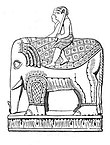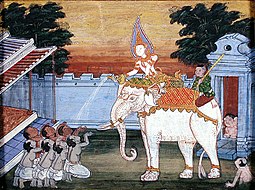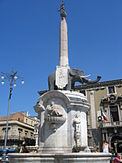Cultural depictions of elephants

Religion, mythology and philosophy
The
The Earth is supported and guarded by mythical
In
Elephants remain an integral part of religion in South Asia and some are even featured in various religious practices.
In the version of the Chinese zodiac used in Northern Thailand, the last year in the 12-year cycle – called "Year of the Pig" in China – is known instead as "Year of the Elephant", reflecting the importance of elephants in Thai culture.
In Islamic tradition, the year 570 is when the Prophet
In the
The unfamiliarity with the exotic beast has also made elephants a subject of widely different interpretations thus giving rise to mythological creatures. The story of the
In art
From Stone Age
Prehistoric
Ancient
Indian
Modern
Elephants are often featured in modern artistic works, including those by artists such as Norman Rockwell,[23] Andy Warhol[24] and Banksy.[25] The stork-legged elephant, found in many of Salvador Dalí's works,[e] is one of the surrealist's best known icons, and adorn the walls of the Dalí Museum in Spain.[26][27][28] Dali used an elephant motif in various works such as Dream Caused by the Flight of a Bee Around a Pomegranate a Second Before Awakening, The Elephants, Swans Reflecting Elephants and in The Temptation of Saint Anthony. The Elephant and Obelisk motif also found its way to various works by this artist. Rembrandt did a series of sketches of the famous 17th century elephant, Hansken, and featured her as a symbol of chastity in his 1638 etching Adam and Eve.[29]
Politics and secular society
The elephant is also depicted by various political groups and in secular society.
In Asia

Asian cultures admire the high intelligence and good memory of Asian elephants. As such, they symbolize wisdom

The elephant also lends its name to some landmarks in Asia. Elephanta Island (also called "Gharapuri Island") in Mumbai Harbour was given this name by 17th century Portuguese explorers who saw a monolithic basalt sculpture of an elephant near the entrance to what became known as the Elephanta Caves. The Portuguese attempted to take it home with them but ended up dropping it into the sea because their chains were not strong enough. Later, the British moved this elephant to the Victoria and Albert Museum (now Dr. Bhau Daji Lad Museum) in Mumbai.[33]
In Europe
Aside from being a curiosity for Europeans, the elephant also became a symbol of military might from the experience of fighting foreign powers that fielded war elephants throughout history.[34] In 326 BC after
In about the year 800 AD, an elephant called Abul-Abbas was brought from Baghdad to Charlemagne's residence in Aachen as a symbol of the beginning of the Abbasid–Carolingian alliance.
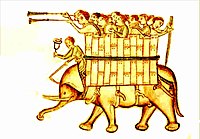
In 1229, the so-called Cremona elephant was presented by Sultan of Egypt Al-Kamil to the Holy Roman Emperor Frederick II, and the elephant was used by the Emperor in parades. The elephant is mentioned in the visit of Frederick's brother-in-law Richard of Cornwall to Cremona in 1241, in the Chronica Maiora of Matthew Paris. The presence of the animal is also recorded in 1237 in the Cremona city annals.

In 1478, the
In the early 1800s

In 1870, the killing and eating of the elephants
The city of Catania, Sicily has an immemorial connection with the elephant. The local sorcerer Heliodorus, was credited with either riding a magic elephant or transforming himself into this animal. Under medieval Arab rule Catania was known as Medinat-ul-Fil or Balad-ul-Fil (City/State of the Elephant). The symbol of the city is the Fontana dell'Elefante (Fountain of the Elephant) assembled in its present form in 1736 by Giovanni Battista Vaccarini.

In Central London, England, an area known as the "
In America

The elephant as the symbol for the
In Africa
Many African cultures revere the African Elephant as a symbol of strength and power.[43][44] It is also praised for its size, longevity, stamina, mental faculties, cooperative spirit, and loyalty.[45] South Africa uses elephant tusks in their coat of arms to represent wisdom, strength, moderation and eternity.[46] The elephant is symbolically important to the nation of Ivory Coast (Côte d'Ivoire); the Coat of arms of Ivory Coast features an elephant head escutcheon as its focal point.
In the western African
-
Ivory Coast coat of arms, (ca 1964–2000)
-
Flag of Siam (Thailand), (1855–1916)
-
Flag of the Kingdom of Laos, (1952–1975)
-
Flag of theKingdom of Dahomey, (ca 1888)
Popular culture
The elephant has entered into popular culture through various
The phrase "Elephants never forget" refers to the belief that elephants have excellent memories. The variation "Women and elephants never forget an injury" originates from the 1904 book Reginald on Besetting Sins by British writer Saki.[48][49]
This adage seems to have a basis in fact, as reported in Scientific American:
- Remarkable recall power, researchers believe, is a big part of how elephants survive. Matriarch elephants, in particular, hold a store of social knowledge that their families can scarcely do without, according to research conducted on elephants at Amboseli National Park in Kenya.[50]
"
Literature

The elephant is viewed in both positive and negative lights in similar fashion as humans in various forms of literature. In fact, Pliny the Elder praised the beast in his Naturalis Historia as one that is closest to a human in sensibilities.[55] The elephant's different connotations clash in Ivo Andrić's novella The Vizier's Elephant. Here the citizens of Travnik despise the young elephant who symbolises the cruelty of the unseen Vizier. However, the elephant itself is young and innocent despite unknowingly causing havoc due to youthful play.[56] In the Tarzan novels of Edgar Rice Burroughs, Tantor is the generic term for "elephant" in the fictional simian Mangani language, but is associated with a particular elephant who eventually becomes Tarzan's faithful companion. Other elephant characters that are shown in a positive light include Jean de Brunhoff's Babar and Dr. Seuss' Horton. Jules Verne featured a steam-powered mechanical elephant in his 1880 novel The Steam House. In addition, the animal is depicted in its military use through the oliphaunts of J. R. R. Tolkien's The Lord of the Rings trilogy and the alien invaders of Larry Niven and Jerry Pournelle's 1985 science fiction novel, Footfall.
Notable Elephants in Rudyard Kipling's short stories are Hathi in several Mowgli stories, Tha in "How Fear Came" which is also a Mowgli story, several elephants but chiefly Kala Nag in "Toomai of the Elephants", Two-Tails in "Her Majesty's Servants" (last chapter of The Jungle Book) and the Elephant's Child in the eponymous Just So story; an elephant also appears as Mark Twain's "The Stolen White Elephant". George Orwell wrote an allegorical essay, "Shooting an Elephant"; and in "Hills Like White Elephants", Ernest Hemingway used the allegorical white elephant, alluding to a pregnancy as an unwanted gift.[57]
The animal is also seen in historical novels. .
Elephants can also represent the hugeness and wildness of the imagination, as in
Sports
The elephant is used as a mascot or logo for various sports groups.
Circus showman P. T. Barnum donated the stuffed hide of Jumbo the elephant to Tufts University in 1885, where Jumbo soon became the mascot for their sports teams. However, all that remains of Jumbo are some ashes stored in a peanut butter jar and a piece of his tail following a fire in 1975. "Jumbo's spirit lives on" in the peanut butter jar which is ceremoniously passed on to successive athletic directors.[63]
The mascot for the
University of Alabama's Crimson Tide mascot has been an elephant since 1930 after a sportswriter wrote of a fan yelling "Hold your horses, the elephants are coming!" as the football team rumbled onto the field.[64] Their elephant-costumed "Big Al" officially debuted at the 1979 Sugar Bowl.
The crest of Kerala Blasters FC, an Indian association football club is designed around an elephant holding football.[65] Elephants are the state animal of Kerala and have a main role in their culture. They are considered as symbol of unity, power, and pride. The crest of the club symbolises the heritage, culture, spirit, and passion of Kerala, and its love for football.[66]
Music
The elephant is also represented in music such as Henry Mancini's hit song "Baby Elephant Walk", which has been described as "musical shorthand for kookiness of any stripe".[67] The American band the White Stripes' fourth album was entitled Elephant in honour of the animal's brute strength and closeness to its relatives.[68] The hit single "Elephant" by British recording artist Alexandra Burke is based on the expression "elephant in the room".[69] "Nellie the Elephant" is a children's song first released in 1956 and since covered by many artists including the punk-rock band Toy Dolls;[70] For her album, Leave Your Sleep, Natalie Merchant set to music "The Blind Men and the Elephant" poem by John Godfrey Saxe, which is based on the parable.[71]
Film and television
The elephant is also featured in film and on television. Thailand has produced various movies about the animal, from the 1940 historical drama film
On television,
The 2016 action-comedy film
Games
The elephant can also be found in games. In
Architecture
In the 18th-century, French architect
Three multi-story elephant shaped buildings were built in America by
Gallery
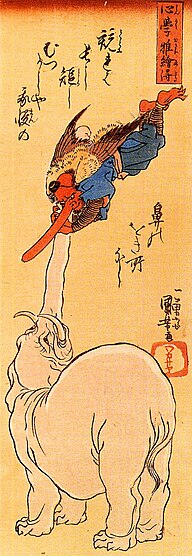
Ukiyo-e print by Utagawa Kuniyoshi
-
Buddhist parable of the blind monks examining an elephant; illustrated by Itchō Hanabusa. (1888 Ukiyo-e woodcut)
-
A royal white elephant in 19th century Thai art
-
Fontana dell'Elefante (Fountain of the Elephant);Catania's symbol
-
Elephant statues at theBuddhist Udaygiri temple ruins in Odisha, India
-
Country Gentleman magazine. Norman Rockwell cover, 16 August 1919
-
African elephant mask (Ivory Coast)
-
Kuosi Society (Bamileke people) Elephant Mask, Brooklyn Museum
-
Hannibal Crossing the Alps; detail of fresco byRome
-
Sree Poornathrayesa temple festival Thrippunithura in Kerala, south India.
-
Erawan statue in Chiang Mai, Thailand
-
Dernier projet pour la fontaine de l'Éléphant de la Bastille (1809–1810), Watercolor by Jean-Antoine Alavoine
-
1354 illustration depicting Panchatantra fable: Rabbit fools Elephant by showing the reflection of the moon
-
Shang dynasty ceramic elephant, Xinxiang Museum
See also
- Great Natof Burma.
- Bholu (mascot), iconic mascot for Indian Railways
- Elephants in ancient China
- Elephants in Kerala culture
- Elephants in Thailand
- Elephant riddle
- Elephant test
- Elephant clock
- Elephant Parade, sculpture exhibit
- Execution by elephant
- Fear of micearticle
- Faithful Elephants, story of the elephants in Tokyo's Ueno Zoo during World War II
- Gaja, elephants in ancient Hindu mythology
- Hastin, elephants in Vedic texts.
- 1962 Film
- Temple elephant
- The Sultan's Elephant, traveling show featuring a huge mechanical elephant
- War elephant
- List of fictional elephants
- List of individual elephants
- National Elephant Day (Thailand)
- Category: Metaphors referring to elephants
Notes
- ^ Ganesha Getting Ready to Throw His Lotus : "In the Mudgalapurāṇa (VII, 70), in order to kill the demon of egotism (Mamāsura) who had attacked him, Gaṇeśa Vighnarāja throws his lotus at him. Unable to bear the fragrance of the divine flower, the demon surrenders to Gaṇeśa."
- Arabic: سورة الفيل — English: The Elephant)
- ^ The plural of cyclops is cyclopes ("sigh-KLO-peez")[13]
- ^ For example, see: Dream Caused by the Flight of a Bee Around a Pomegranate a Second Before Awakening and The Elephants
- ^ "The elephant is seen, not only as a beast so strong that he can carry a tower – Coventry's castle – full of armed men, but also as a symbol of Christ's redemption of the human race."[37]
- ^ cf: Dumbarton Civic Coat of Arms and Dumbarton Football Club crest
- ^ Although the caption quotes the fable, Nast attributes it to —Shakespear or Bacon
- ^ Contrary to popular belief, Nast did not originate the donkey (a derogatory reference to Andrew "Jackass" [Jackson]) as the symbol of the Democratic Party[40][41]
- ^ Guezo and Glele ruled from 1818 to 1858 and from 1858 to 1889, respectively
- ^ As a product size, by 1886 (cigars); Jumbo jet attested by 1964.[54]
- ^ Kongo: Nzamba[54]
- ^ Over the years, the A's elephant mascot has appeared in various colours other than white, and was briefly replaced by a mule
- ^ US title: The Protector, UK title: Warrior King
- ^ The first book Mumfie Marches On, published during World War II (1942) was suggested by the British government; which culminates in the capture of Adolf Hitler by Mumfie and allies[72]
- ^ From Persian پيل pīl; al- is the Arabic for "the"
- ^ Xiangqi (Chinese: 象棋, p Xiàngqí), sometimes translated as "the elephant game".[76]
References
- ^ Plate 39 (23), A guide to the principal gold and silver coins of the ancients, from circ. B.C. 700 to A.D. 1 (1889); British Museum. Dept. of Coins and Medals : "AR. Demetrius"
- ISBN 9780715333938. Retrieved 6 December 2012.
- ^ "Elephant". Myths, legends, beliefs and traditional stories from Africa. A-gallery. Archived from the original on 28 December 2008. Retrieved 6 December 2012.
- Bochasanwasi Shri Akshar Purushottam Swaminarayan Sanstha. Retrieved 8 February 2013.
- ISBN 978-0791406564.
- ^ "Life of Buddha (part 1) : Queen Maha Maya's Dream". BuddhaNet. Buddha Dharma Education Association.
- ISBN 978-0195173987.)
{{cite book}}: CS1 maint: multiple names: authors list (link - ISBN 978-0313359392.)
{{cite book}}: CS1 maint: multiple names: authors list (link - ISBN 978-0198810780.
- ISBN 1-930409-11-7
- JSTOR 25728163.
- ^ "Medieval Bestiary : Elephant". Medieval Bestiary. Retrieved 12 December 2012.
- ^ a b c "Greek Giants". American Museum of Natural History. Retrieved 24 January 2014.
- ISBN 9781605010915.
- ISBN 978-1933143187.
- ^ "Rock-Art Sites of Tadrart Acacus". UNESCO World Heritage Centre. Retrieved 11 December 2012.
- Public Library of Science.
- ^ "Phillip's Cave". Info Namibia. Retrieved 16 March 2013.
- ISBN 978-0415115858.
- ^ "Shaped Stone of the Sahara". Artsy. Pace Primitive. Retrieved 8 April 2019.
- ISSN 1013-7521. Archived from the original(PDF) on 15 November 2012. Retrieved 12 December 2012.
- ISBN 0300062176, pp. 278-83
- ^ "Two Boys on an Elephant by Norman Rockwell". Best Norman Rockwell Art.com. Retrieved 12 December 2012.
- ^ "African Elephant, 1983 – Andy Warhol". The Endangered Species portfolio. Coskun Fine Art. Archived from the original on 16 October 2014. Retrieved 11 December 2012.
- ^ Wyatt, Edward. A Splashy Los Angeles Debut by Banksy – Design – New York Times, Published 16 September 2006. Retrieved 11 December 2012
- ^ "Salvador Dali Gallery – Memories of Surrealism : Space Elephant". SalvadorDaliExperts.com. Archived from the original on 7 April 2013. Retrieved 12 December 2012.
- ^ In Kerala the elephant is a most popular motif in temple and church art, architecture, sculpture. See e.g. George Menachery, The Elephant and the Christians, (Malayalam) South Asia Research Assistance Services, 2014, foreword by Madambu Kunjikkuttan)
- ^ "Aanayum Nazraniyum" (PDF).
- ^ Keats, Jonathon. "Portrayed By Rembrandt, The 17th Century's Most Famous Elephant Is Still Teaching Us About Wildlife". Forbes. Retrieved 6 July 2022.
- ISBN 978-1402770043.
- ISBN 9788126018031.
- ISBN 9781900949811.
Elephants Kerala culture.
- ^ HT Cafe, Mumbai, Monday, 4 June 2007 p. 31; Article: "Lord of the Islands" by Jerry Pinto
- ISBN 978-0415320894.
- ISBN 978-0226467504.
- ^ Bingham, Denis (1901). The Bastille, Volume 2 (eBook). Princeton University: J. Pott. p. 447.
- ^ "Coat of Arms : History of the Coat of Arms". Coventry City Council. Archived from the original on 14 July 2014. Retrieved 13 June 2014.
- ^ "The History of the National Fire Safety Charity for Children". Welephant web site. National Fire Safety Charity for Children. Archived from the original on 28 July 2012. Retrieved 4 March 2013.
- ^ Cartoon of the Day: "The Third-Term Panic" Archived 21 September 2011 at the Wayback Machine. Retrieved on 2008-09-01
- ^ "How the parties got their animal symbols". (CBS News). CBS Interactive Inc. Retrieved 25 December 2013.
- ISBN 978-0814719855.
- ^ Kennedy, Robert C. "The Third-Term Panic". Cartoon of the Day. HarpWeek. Archived from the original on 26 December 2013. Retrieved 25 December 2013.
- ^ "383. African Elephant (Loxodonta africana)". EDGE: Mammal Species Information. Retrieved 7 December 2012.
- ^ "West African Elephants". Convention on Migratory Species. Archived from the original on 10 July 2013. Retrieved 7 December 2012.
- ^ "Elephant: The Animal and Its Ivory in African Culture". Fowler Museum at UCLA. Archived from the original on 30 March 2013. Retrieved 24 January 2013.
- ^ "National Coat of Arms". South African Government Information. Archived from the original on 4 September 2012. Retrieved 7 December 2012.
- ^ "Elephant Figure | Fon peoples | The Met". The Metropolitan Museum of Art. Retrieved 12 December 2017.
- ^
 English Wikiquote has quotations related to: Saki#Reginald (1904)
English Wikiquote has quotations related to: Saki#Reginald (1904)
- ^ Jenkins, Dr. Orville Boyd (1 June 2001). "Why Elephants Never Forget". Retrieved 7 December 2011.
- ^ Ritchie, James. "Fact or Fiction?: Elephants Never Forget". Scientific American. Retrieved 5 December 2012.
- ^ a b Wilton, Dave (13 June 2006). "elephant, to see the". Wordorigins.org. Archived from the original on 16 July 2014. Retrieved 30 July 2014.
- ^ "Seeing the Elephant". Historic Nantucket. Nantucket Historical Association. Retrieved 30 July 2014.
Originally published in the Historic Nantucket, Vol 48, no. 3 (Summer 1999), p. 28
- ^ "SEEING THE ELEPHANT". The New York Times. 1 March 1861. Retrieved 30 July 2014.
- ^ a b c Harper, Douglas. "jumbo". Online Etymology Dictionary. Retrieved 13 December 2012.
- ISBN 9780252091339.
- ^ "Priča o vezirovom slonu/The Story of the Vizier's Elephant". The Ivo Andrić Foundation. Archived from the original on 2 May 2012. Retrieved 7 December 2012.
- S2CID 161839831.
- ^ "1998 : José Saramago". The Nobel Prize in Literature. Nobelprize.org. Retrieved 17 December 2012.
- ^ Le Guin, Ursula K (24 July 2010). "The Elephant's Journey by José Saramago". Book of the week. London: Guardian News and Media Limited. Retrieved 17 December 2012.
- ISBN 978-0670075461.)
{{cite book}}: CS1 maint: multiple names: authors list (link - ^ Review by Robin Morrow "Too Many Elephants in This House" Magpies Vol.27 2012 p.8
- ^ "Definition of heffalump in English". Oxford Dictionary. Vol. British & World English (Online ed.). Oxford University Press. 2014. Archived from the original on 3 February 2014. Retrieved 20 January 2014.
- ^ "Jumbo the Elephant, Tufts' Mascot". Get to Know Tufts. Tufts University. Retrieved 10 September 2014.
- ^ "Big Al". Crimson Tide. CBS Interactive. Archived from the original on 13 May 2014. Retrieved 10 May 2014.
- ^ "Kerala Blasters FC launch logo". Indian Super League. Retrieved 20 February 2021.
- ^ NCFL (26 October 2016). "ISL Logos: Meaning and symbolism behind the Logos of each ISL team". www.sportskeeda.com. Retrieved 20 February 2021.
- ^ Mills, Ted. "Henry Mancini : Hatari! : Review". AllMusic. All Media Network.
- ^ DiCrescenzo, Brent (1 April 2003). "The White Stripes: Elephant". Pitchfork. Retrieved 8 February 2013.
The album title refers to the endangered animal's brute power and less honored instinctual memory for dead relatives
- ^ Love, Ryan (10 January 2012). "Alexandra Burke interview: 'Elephant is just the beginning'". Digital Spy. Hearst Magazines UK. Retrieved 24 January 2013.
- ^ "Nellie the Elephant (lyrics only)". NIEHS Kids Pages. National Institute of Environmental Health Sciences. Archived from the original on 28 February 2013. Retrieved 23 February 2013.
- ^ op de Beeck, Nathalie (31 December 2012). "Q & A with Natalie Merchant". www.publishersweekly.com. PWxyz, LLC. Retrieved 19 January 2019.
- ISBN 978-0748616510.
- ^ "This scene almost got Sacha Baron Cohen's upcoming film a NC-17 rating". www.aol.com. AOL. 10 July 2020. Archived from the original on 5 July 2020. Retrieved 11 July 2020.
- ^ Reproduction from Ars Oratoria, 1482 via Donald M. Liddell, Chessmen (New York, 1937)
- ISBN 978-0399115752.
- ^ "How to Play Chinese Chess : Xiangqi". AncientChess.com. Retrieved 24 February 2014.
- ISBN 9780786494279.
Finally, the two-horn protuberances that identified the abstract style Arab piece, symbolizing animal's tusks, were assimilated into the cleft miter borne by the bishops, giving it its English identity.
- ^ "Chang (Elephant) Building". BKK Kids. 9 October 2013. Archived from the original on 9 March 2014. Retrieved 10 March 2014.
Further reading
- Scigliano, Eric (2002). Love, War, and Circuses: The Age-Old Relationship Between Elephants and Humans. Boston: Houghton Mifflin. ISBN 978-0618015832.
- Binney, Ruth (2006). Nature's Ways: Lore, Legend, Fact and Fiction. Newton Abbot: F+W Media. ISBN 978-0715333938.
- Ed Cray and Marilyn Eisenberg Herzog (January 1967). "The Absurd Elephant: A Recent Riddle Fad". Western Folklore. 26 (1): 27–36. JSTOR 1498485.—the evolution of the Elephant Riddle that entered U.S. folklore in California in 1963
- Druce, George C. "The Elephant in Medieval Legend and Art" Archived 19 July 2012 at the Wayback Machine. Journal of the Royal Archaeological Institute. (Vol. 76) London, 1919
- Robbins, Louise E. (2002). Elephant Slaves and Pampered Parrots: Exotic Animals in Eighteenth Century Paris ([Online-Ausg.] ed.). Baltimore [u.a.]: Johns Hopkins Univ. Press. ISBN 978-0801867538.
- ISBN 978-1879941410.
- Pichayapat Naisupap "The Emblematic Elephant: Elephants, the Dutch East India Company, and Eurasian Diplomacy in the Seventeenth Century". Master Thesis, Colonial and Global History, Leiden University, 2020.
- ed, Fowler Museum of Cultural History. Doran H. Ross (1992). Elephant: The Animal and Its Ivory in African Culture. Los Angeles: University of California. ISBN 978-0930741266.
- ISBN 978-1400838448.
- African Folktale as told by Humphrey Harman. "Thunder, Elephant, and Dorobo" (PDF). greatbooks.org. Great Books Foundation.
External links
- "Elephants in Culture". Infoqis Publishing, Co. Archived from the original on 19 June 2012. — Elephant-World.com
- "Elephant". Myths, legends, beliefs and traditional stories from Africa. A-Gallery. Archived from the original on 28 December 2008.
- "Elephants on Parade – Medieval and Earlier Manuscripts". British Library. The British Library Board. — Depictions from illuminated manuscripts





